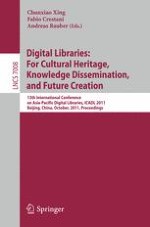2011 | Buch
Digital Libraries: For Cultural Heritage, Knowledge Dissemination, and Future Creation
13th International Conference on Asia-Pacific Digital Libraries, ICADL 2011, Beijing, China, October 24-27, 2011. Proceedings
herausgegeben von: Chunxiao Xing, Fabio Crestani, Andreas Rauber
Verlag: Springer Berlin Heidelberg
Buchreihe : Lecture Notes in Computer Science
